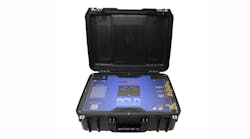Importance of detecting EV battery leaks
Electric vehicle manufacturers and users tout the many benefits of these quiet and quick emissionless machines, such as the reduction in maintenance. Sure there are no aftertreatment systems or oil changes to perform, but EVs have plenty of fluids running about the battery compartment. And that means EV service providers need to master some new tools to ensure the integrity of these systems.
Diagnostic leak detection technology provider Redline Detection, is currently demonstrating its new solution, the Battery + Coolant Leak Detector, at ConExpo-ConAgg, Booth# N10532 in the North Hall.
The BCLD’s job is to pinpoint leaks in electric vehicle battery enclosures, battery coolant systems, and other EV system components with 100% accuracy. This is to ensure there is no presence of water, dust, or other contaminants, which could cause a catastrophic thermal event. Technicians would use the device during battery service and repair, battery exchange, after any collision, and as normal preventive maintenance. OEMs have deemed the tool as essential. The solution came out in 2022 and is currently being used by EV fleets at Amazon Delivery, UPS, Walmart and the U.S. Postal Service.
Fleet Maintenance asked Alex Parker, president of Redline Detection to discuss a little more about the tool and the importance of EV battery diagnostics in general.
Fleet Maintenance: People might think EV and just imagine wires and electricity. Why is the Battery + Coolant Leak Detector necessary?
Alex Parker: The powertrain system in an EV is so much more! Beginning with the battery enclosure, the battery coolant system is incredibly complex, often like a system of arteries running throughout the battery modules. It’s essential to ensure that there is no intrusion of coolant fluid into the battery modules.
Any leaks in the system—whether they be from the internal coolant system, or a leak around the seal of the battery enclosure—that allows road dust or fluid intrusion into the battery compromises system efficiency and ultimately creates the risk of a thermal runaway event, a chain of reactions within the EV system that results in a fire so fast and so hot it is nearly impossible to extinguish. This would obviously endanger drivers and technicians.
BCLD ensures that battery enclosures, battery coolant systems, and other EV components are sealed to factory safe. It is the only solution with patented technology that will not only verify if there is a leak, but will also pinpoint the leak location, with live graphing and data logging to ensure all stakeholders that their commercial vehicles are ready to go back to work. The BCLD pinpointing capability allows fleets to find leaks, make the repair, and get vehicles back in service fast, dramatically increasing uptime for EVs.
FM: What specific type of trucks and heavy equipment have you seen electrified and that can benefit from this technology?
AP: In Europe, we are seeing incredibly rapid adoption of commercial electric vehicles, while in the U.S., smart fleets are recognizing that EV plays a valuable role in the larger assortment of fleet vehicles. Government fleets, municipalities and commercial fleets—everything from construction equipment to electric busses to last mile delivery vehicles will benefit from BCLD technology.
This leak tester is already being used by OEMs during the vehicle design process, for end-of-line testing, by battery manufacturers, at workshop, and at collision repair locations.
FM: What are some issues stemming from not detecting leaks in EVs?
AP: Along with the worst-case scenario of a thermal runaway, any intrusion of water or dust into the battery enclosure and powertrain components can result in component failure, resulting in excessive downtime and expense. Ensuring the seal integrity of the battery enclosure and components is critical for safety and longevity of the EV.
Electric vehicle systems must be tested to ensure that there are no leaks after ANY battery repair or maintenance, after a torsion event such as towing the vehicles, and after any collision. In heavy duty, off road, construction, mining, agriculture equipment, ensuring that battery systems are sealed needs to be part of preventive maintenance.




